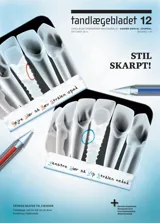Huskeregel (RB-RB/LB-LB) til røntgenoptagelse af tandimplantater
Introduktion – Optimale periapikale røntgenbilleder er en forudsætning for at kunne kontrollere knogleforholdene omkring implantater efter indsættelse. Formål – At evaluere en huskeregel i forbindelse med røntgenkontrol af skrueformede implantater. Materiale og metoder – Tandlægestuderende blev instrueret i anvendelse af RB-RB/LB-LBhuskereglen: Hvis gevindet fremstår uskarpt på højre side af implantatet (Right Blur), skal røntgenstrålen hæves (Raise Beam) for at opnå skarpt gevind på begge sider af implantatet, og tilsvarende, hvis gevindet er uskarpt på venstre side af implantatet (Left Blur), skal røntgenstrålen sænkes (Lower Beam). Periapikale røntgenoptagelser blev foretaget af fire implantater indsat med forskellig vinkling i en Frasaco OK/UK-model. De studerende optog et nyt billede af hvert implantat – med anvendelse af reglen – indtil et acceptabelt resultat var opnået. Alle billeder blev vurderet ”blindt” til én af fire kategorier; 1: perfekt, 2: ikke perfekt, men klinisk acceptabelt, 3: ikke acceptabelt og 4: håbløst. Resultater – For alle implantater gjaldt, at der opnåedes en bedre score i 64 % af omtagningerne, 28 % fik samme score, og 8 % fik en dårligere score. Der sås kun en lille variation mellem implantater med forskellig vinkling. I gennemsnit skulle der to optagelser til pr. implantat (interval: 1-8) for at opnå et klinisk acceptabelt billede. Konklusion – RB-RB/LB-LB-huskereglen anvendt i forbindelse med optagelse af optimalt projicerede periapikale røntgenbilleder af tandimplantater kunne nemt implementeres af uerfarne klinikere. Originalartikel var publiceret i Dentomaxillofacial Radiology: Schropp L, Stavropoulos A, Spin-Neto R, Wenzel A. Evaluation of the RB-RB/LB-LB mnemonic rule for recording optimally projected intraoral images of dental implants: an in-vitro study. Dentomaxillofac Radiol 2012;41:298-304.
The RB–RB/LB–LB mnemonic rule for radiographs of implants
Introduction – Optimal periapical radiographs are a prerequisite in controlling the bone conditions around implants after placement. Aim – To evaluate a simple mnemonic rule in relation to radiographic follow-up of screw-type implants. Methods – Dental students were instructed in the RB–RB/LB–LB mnemonic rule: if implant threads are blurred at the right side of the implant (Right Blur), the x-ray beam direction must be raised (Raise Beam) to obtain sharp threads on both implant sides; and correspondingly if implant threads are blurred at the left side of the implant (Left Blur), the x-ray beam direction must be lowered (Lower Beam). Intraoral radiographs of four screw-type implants placed with different inclination in a Frasaco upper or lower jaw dental model were recorded. The students were instructed to reexpose each implant, implementing the mnemonic rule, until an image of the implant with acceptable quality was obtained. Subsequently, each radiograph was assessed blind and assigned to one of four quality categories; 1: perfect, 2: not perfect, but clinically acceptable, 3: not acceptable, and 4: unusable. Results – For all implants, a better score was obtained in 64% of the re-exposures, 28% received the same score, and 8% obtained a worse score. Only a small variation was observed among exposures of implants with different inclination. On average, two exposures per implant (range: 1-8) were needed to obtain a clinically acceptable image. Conclusions – The RB–RB/LB–LB mnemonic rule for recording periapical radiographs of dental implants with a correct projection was easy to implement by inexperienced examiners.


